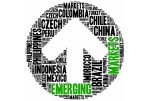The silent revolution in EMD (Roundtable EMD – part 1)
The silent revolution in EMD (Roundtable EMD – part 1)

This report was originally written in Dutch. This is an English translation.
Over the past ten to fifteen years, the EMD market has undergone a clear shift from hard currencies to local currencies. How big is the market now and what opportunities are there? Financial Investigator organised a round table discussion on this topic. Four experts engaged in a discussion led by Harry Geels, Senior Investment Advisor at Auréus.
By Hans Amesz
This is part 1 of the report. Part 2 will be published on Thursday 5 June and part 3 on Wednesday 11 June.
|
Moderator Harry Geels, Auréus
Participants Rob Drijkoningen, Neuberger Berman Asbjörn Friederich, Nuveen Naki Nartey, PIMCO Raymond van Wersch, PGGM |
How big is the EMD market now, both in local and hard currencies? Has it grown in recent years? If so, why?
Rob Drijkoningen: 'The EMD market is worth around $42 trillion and is growing by an average of 14% per year. These figures come from Bank of America.
Of course, there are varying figures, but most of the growth comes from local currencies and longer-term corporate bonds. External debt is more limited, but that is what people usually refer to when they talk about emerging market debt, i.e. mainly hard currencies such as dollars. Local debt remains somewhat underexposed.'
Naki Nartey: 'What is interesting about emerging markets is that most of the market is off-benchmark. There is $42 trillion in bonds outstanding, but the local debt that qualifies as a benchmark is around $5 trillion, and hard currency $1 trillion. Corporate debt is another $1 trillion. Unlike developed markets, the vast majority of these bonds are therefore not included in the official indices. This makes the opportunities for active managers more interesting, given their ability to invest off-benchmark.'
Drijkoningen: 'Many issues come from specific countries, particularly China. China has the largest share both locally and externally. At country level, there are restrictions on how much a country can issue in benchmarks. So a lot of issuance is simply not possible there. In addition, much of it is onshore, i.e. locally financed. In the past, emerging markets did not have good local yield curves, which meant they had to borrow in dollars. That created currency risks. Nowadays, you see a natural shift towards local issues, especially in China and India.'
Raymond van Wersch: 'Over the past ten to fifteen years, we have seen a clear shift from hard currencies to local currencies. Government bonds in hard currencies have historically had a riskier profile than government bonds in local currencies.'
Nartey: 'That depends on how you define risk. Local currencies offer better credit quality on average, but also more volatility due to the currency component. Hard currencies have lower credit quality on average, with more high-yield issuers. But if the currency risk is removed, you only take spread and credit risks, which are generally less volatile than FX.'
Drijkoningen: 'The local currency index, for example the Government Bond Index – Emerging Markets, the GBI-EM, only includes 18 to 20 countries, while the hard currency index, for example the Emerging Markets Bond Index, the EMBI, includes more than 70. But that does not reflect the underlying market of local currencies, which is much broader. Many countries and currencies are simply not eligible for the benchmark because they are not liquid enough. In hard currencies, you see the opposite: many names for a smaller underlying market. Of the approximately 72 countries in the EMBIGD, 27% represent around 80% of the weights. So it is fairly concentrated. If you diversify beyond the benchmark, you can generate alpha without necessarily taking on more risk.'
A few years ago, we often talked about frontier markets. You hardly hear that term anymore. Have those markets disappeared?
Drijkoningen: 'No, they still exist. There is one important difference, though: in hard currency, frontier countries are often already represented in the EMBI Global and NEXGEM benchmarks, while in local currency they are largely complementary because liquidity is often too low to be included in the standard index for EMD, such as the GBI–EM.'
Van Wersch: 'If you really want to make an impact, for example in the area of sustainability or transition, it helps to invest in frontier markets. Especially through local currencies, because that helps governments the most. We are investigating whether frontier markets can become a separate subset within our allocation to EMD local currencies.'
Nartey: 'We include frontier exposure in our global EMD portfolios, in both hard and local currencies where possible. We are even seeing more and more clients asking for a dedicated frontier portfolio, often for ESG or impact reasons. There are interesting opportunities in these markets, partly because returns there have been good recently.'
Drijkoningen: 'Yes, frontier local via the FTSE index is performing much better than the regular local currency index: around 5% more per year since 2017. It is a good diversifier and alternative source of returns. We use it both opportunistically and in a mandate against a frontier benchmark.'
Friederich: 'We do the same and have frontier exposure in both hard and local currencies, but in general we maintain diversified exposure to avoid blow-up risks.'
Van Wersch: 'Our own research data confirms that frontier markets in local currency outperform regular EM local. An index is now being launched that reflects this. Moreover, the maximum drawdown in frontier markets during crisis years is often lower than in regular emerging markets, also due to the general absence of large investors in frontier markets. It could therefore be an interesting diversification.'
What is the typical risk/return profile of local currency debt?
Drijkoningen: 'It is certainly riskier than hard currency debt in terms of volatility. In local currencies, you can limit risks by financing in euros instead of dollars, for example, which reduces volatility. This is particularly true if you choose currencies with low correlation.'
Friederich: 'That's right. In general, the biggest drawdowns in local benchmarks are due to the FX component, especially for dollar portfolios. If you finance in euros, you reduce that risk considerably and the picture becomes more attractive.'
Nartey: 'With local currencies, FX is the most volatile component, and then you also have local duration. With hard currencies, there is usually dollar duration and spread risk. Obviously, the FX component is the most volatile, the dominant risk factor. If you look at it from the perspective of euros or pounds, local currencies often look better because the dollar has strengthened over the past ten years.'
Van Wersch: 'We have chosen to invest exclusively in local currencies because government bonds in hard currencies are too similar to US dollar high yield and EM corporates in hard currencies. That is why we believe that local government bonds offer us better diversification. Last year, 2024, was not a good year for local currencies, but valuations are becoming increasingly attractive and local currency government bonds could benefit from a weaker US dollar.'
How do you deal with currency volatility?
Drijkoningen: 'You can hedge some of that volatility, for example through currency hedging. However, when interest rates are much higher than in the US, you give up much of the interest rate advantage, so that is not a permanent option. Now that US interest rates are higher, while countries such as China have very low yields of around 2%, hedging is becoming attractive. So the picture is nuanced. Strategic hedging can make sense, with room to deviate from it tactically.'
Nartey: 'We calibrate the size of positions with their volatility. If we find two currencies equally attractive, but one is more volatile, it will be given a smaller position in portfolios. This keeps the risk manageable.'
Drijkoningen: 'Volatility can be treacherous. Some currencies appear stable until they suddenly start to move sharply. Egypt is a classic example of this, Nigeria another. After a devaluation, you lose a lot. That's why you shouldn't just look at historical volatility, but also at implied volatility, as priced in the forwards.'
Nartey: 'I agree. We use implied volatility as part of our process.'
China is now the biggest player in the EMD market. How do you see China's role now and in the future?
Nartey: 'At the moment, we are quite bearish on China, both locally and in hard currency. The reasons for this are, first, low returns, which create better opportunities elsewhere. Second, the relationship between China and the United States is quite tense and could deteriorate further. Third, China has become less important for EM growth than in the past. In the past, when China grew, EM countries grew with it and vice versa. Over the past two years, we have seen China's growth slow down, but growth in emerging markets has actually been quite robust.'
Drijkoningen: 'We do have to distinguish between bonds in USD and those in local currencies. We are also underweight in the Chinese currency. But if you hedge the bonds against the dollar, you get about 3% extra. Then it's not a bad investment. The domestic market remains huge. State-owned companies in particular remain active. There is also a lot of innovation, for example in batteries, electric vehicles and technology. That's not going to disappear overnight.'
Friederich: 'The problem with Chinese corporate bonds is that there is little transparency regarding credit quality. We are significantly underweight in China, except for a few specific strong companies that mainly produce for the United States. These corporate bonds offer a Chinese 'postcode premium” compared to comparable US companies. We are seeing increasing demand for EM funds without China, i.e. ex-China benchmarks.'
|
Harry Geels Harry Geels is Senior Investment Advisor at Auréus. He also works part-time as a lecturer at the Actuarial Institute. He is the author of several books, including “Beleggen met Technische Analyse” (Investing with Technical Analysis). Geels studied Financial Economics at VU University Amsterdam. |
|
Rob Drijkoningen Rob Drijkoningen is Head of Fixed Income Europe and Co-Head of the EMD team at Neuberger Berman, where he joined in 2013. Prior to that, he spent nearly 18 years at ING Investment Management in various roles, including Global Head of the EMD team, Head of Multi-Assets and Head of Global High Yield. He began his career on the sell side at Nomura and Goldman Sachs in 1990. |
|
Asbjörn Friederich Asbjörn Friederich is Senior Director and Research Analyst at Nuveen's International and EMD team, focusing on European, Middle Eastern and North African sovereign bond issuers. Prior to joining Nuveen, he worked in Macro Strategy & Sovereign Analysis at Fidelity Investments. He began his career on the sell side at UBS Investment Bank. |
|
Naki Nartey Naki Nartey is Senior Vice President and Emerging Markets Product Strategist at PIMCO. She previously worked in institutional fixed income sales at BBVA, where she managed European bonds and North American EM accounts. Prior to that, she was Product Specialist for emerging markets at JPMorgan Private Bank in New York and held positions at JPMorgan Private Bank in Geneva and JPMorgan Investment Bank in London. |
|
Raymond van Wersch Raymond van Wersch is Senior Portfolio Manager at PGGM, where he has worked since 2005, spending the first 10 years in the Credit Risk Sharing team and then in the Manager Selection team, focusing on Credit and EMD. Prior to that, he set up and managed the European high yield portfolio at NIBC Asset Management and ABP. He previously managed fixed income portfolios at Achmea. He started his career at Rabobank. |














